名词与代词
1名词和代词

Contents●第一章:重点词性●名词、代词、形容词、冠词●动词、副词●第二章:句子成分●主语、谓语、宾语●附加成分与句型结构●第三章:各类句子与从句●并列结构、并列句与主谓一致●名词性从句●状语从句●定语从句●第四章:非谓语轻松搞定●动名词●分词●动词不定式与独立主格●第五章:语气句型●虚拟语气●省略句●倒装句●第一章第一讲:名词●名词的基本用法:basic usage of the nouns●名词的分类:types of noun●名词的数:number of noun●名词的格:case of noun●一.名词的概念和基本用法●名词是词性的一种,也是实词的一种,是指代人、物、事、时、地、情感、概念等实体或抽象事物名称的词。
如:●人的名字(Henry 亨利、Jack 杰克、Bingyu 炳玉);●职业称呼(doctor 医生、pilot 飞行员)(推荐歌曲peerless);●物品名称(radio 收音机、watch 手表);●地名(London、Paris);●抽象概念(courage 勇气、behaviour 举止)等。
●名词经常与其他词连用形成名词短语,如:●the man;●the woman next door;●that tall building等。
二.名词的分类Practice:1.I’ve read __________ sports news about the F1 race today.A. twoB. piecesC. two piecesD. two pieces of2.My teacher gave me __________.A. a good adviceB. some good advicesC. some good adviceD. good advices三.名词的数1.名词的单数和复数形式拼写规则单数复数一般情况下大多数名词后面加-s cattubcatsTubs以-o,-s,-x,-ch,-sh结尾的名词后加-es potatoclassboxwatchbrushpotatoes(区别photos)classesboxeswatchesBrushes辅音字母+-y结尾的普通名词,去-y加-ies;但注意元音字母+-y结尾的名词直接加-s countryboycountriesboys以-y结尾的专有名词后面加-sKennedy Kennedys以-f,-fe结尾的名词,把-f,-fe变为-veswife wives不规则变化manoxsheepmenoxensheep ●Practice:●写出下列词的复数● 1.book______ 2.bus ______ 3.orange _______● 4.baby______ 5.boy______ 6.my __________●7.his_______ 8.knife______ 9.watch_______●10.sheep ____ 11. tooth _____ 12. leaf ______●13.German________ 14.Chinese_________● 1. books 2. buses 3. oranges● 4. babies 5. boys 6. our● 7. their 8. knives 9. watches ● 10. sheep 11. teeth 12. leaves● 13. Germans 14. Chinese●四.名词的格●概念和作用:“名词所有格”狭隘一点可以理解为某一名词(物或者人)被另一名词(物或者人)所拥有的一种表达格式。
名词与代词的知识点梳理
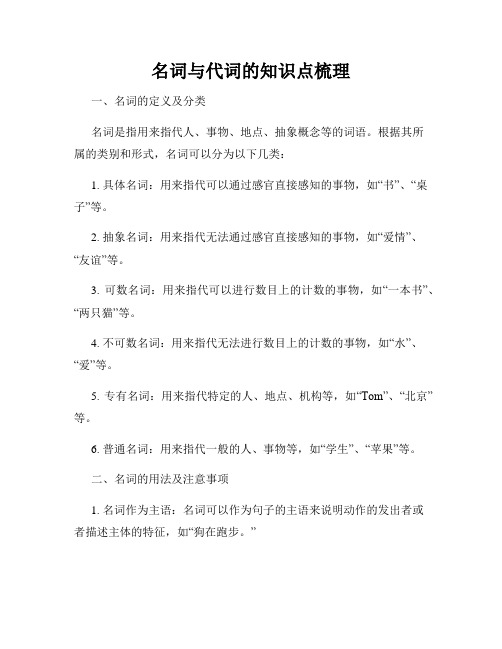
名词与代词的知识点梳理一、名词的定义及分类名词是指用来指代人、事物、地点、抽象概念等的词语。
根据其所属的类别和形式,名词可以分为以下几类:1. 具体名词:用来指代可以通过感官直接感知的事物,如“书”、“桌子”等。
2. 抽象名词:用来指代无法通过感官直接感知的事物,如“爱情”、“友谊”等。
3. 可数名词:用来指代可以进行数目上的计数的事物,如“一本书”、“两只猫”等。
4. 不可数名词:用来指代无法进行数目上的计数的事物,如“水”、“爱”等。
5. 专有名词:用来指代特定的人、地点、机构等,如“Tom”、“北京”等。
6. 普通名词:用来指代一般的人、事物等,如“学生”、“苹果”等。
二、名词的用法及注意事项1. 名词作为主语:名词可以作为句子的主语来说明动作的发出者或者描述主体的特征,如“狗在跑步。
”2. 名词作为宾语:名词可以作为句子的宾语来接受动作的影响或者描述动作的承受者,如“我喜欢电影。
”3. 名词作为定语:名词可以作为另一个名词的修饰语,用来描述被修饰名词的属性、特征等,如“树叶”、“学生证”等。
4. 名词作为补语:名词可以作为补语出现在谓语动词的后面,用来补充说明主语或宾语的身份、性质等,如“他是医生。
”5. 使用专有名词时首字母需大写,使用普通名词时首字母需小写。
6. 注意名词的单复数形式的变化,如“apple”(单数)和“apples”(复数)。
三、代词的定义及分类代词是指用来代替名词或名词性短语的词语。
根据其在句子中所代表的对象或代词的功能,代词可以分为以下几类:1. 人称代词:用来指代说话人、被说话人或者与说话人和被说话人相关联的第三者,如“我”、“你”、“他”等。
2. 物主代词:用来指代某个具体的所有者或凭借关系的拥有者,如“我的”、“你的”、“他的”等。
3. 指示代词:用来指代某个具体的事物或人,起指示作用,如“这”、“那”等。
4. 疑问代词:用来提出问题或表示怀疑,如“什么”、“谁”等。
名词与代词的区别及用法
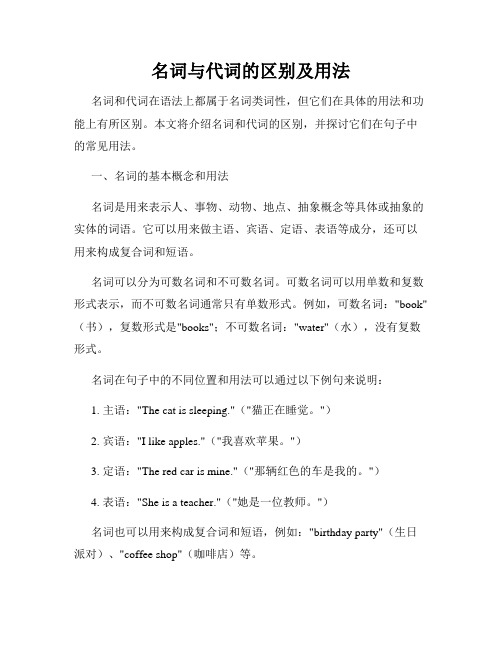
名词与代词的区别及用法名词和代词在语法上都属于名词类词性,但它们在具体的用法和功能上有所区别。
本文将介绍名词和代词的区别,并探讨它们在句子中的常见用法。
一、名词的基本概念和用法名词是用来表示人、事物、动物、地点、抽象概念等具体或抽象的实体的词语。
它可以用来做主语、宾语、定语、表语等成分,还可以用来构成复合词和短语。
名词可以分为可数名词和不可数名词。
可数名词可以用单数和复数形式表示,而不可数名词通常只有单数形式。
例如,可数名词:"book"(书),复数形式是"books";不可数名词:"water"(水),没有复数形式。
名词在句子中的不同位置和用法可以通过以下例句来说明:1. 主语:"The cat is sleeping."("猫正在睡觉。
")2. 宾语:"I like apples."("我喜欢苹果。
")3. 定语:"The red car is mine."("那辆红色的车是我的。
")4. 表语:"She is a teacher."("她是一位教师。
")名词也可以用来构成复合词和短语,例如:"birthday party"(生日派对)、"coffee shop"(咖啡店)等。
二、代词的基本概念和用法代词是用来代替名词或名词词组的词语,在句子中可以发挥名词的作用。
代词分为人称代词、物主代词、指示代词、疑问代词、关系代词、不定代词等。
1. 人称代词:用来表示说话人、被说话人或与被说话人有关的人或事物。
例如:"I"(我)、"you"(你)、"he"(他)、"she"(她)、"they"(他们)等。
名词代词知识点总结

名词代词知识点总结名词是指人、事、物的名称,在句子中可以作主语、宾语、定语和状语等。
而代词是用来代替名词的词语,能够起到指代作用。
名词代词是英语中非常重要的一部分,掌握好名词代词的用法对提高英语水平至关重要。
名词的种类名词分为普通名词和专有名词,普通名词是指不特指某一个人或事物的名词,专有名词是指特指某一个人或事物的名词。
1. 普通名词普通名词又分为可数名词和不可数名词。
可数名词是指可以用数目来计算的名词,如book、table、apple等;而不可数名词是指不能用数目来计算的名词,如water、rice、coffee等。
2. 专有名词专有名词是指特指某一个人或事物的名词,例如人名、地名、组织名等。
专有名词的首字母通常要大写,如China、Beijing、Mike等。
名词的单复数形式名词的单数形式和复数形式的变化规则是不同的,需要根据名词的词尾和词根来进行变化。
1. 名词的复数形式一般情况下,名词的复数形式是在其词尾加上“-s”或“-es”,如books、tables、dishes等;但有些名词的复数形式是不规则的,需要记忆,如man-men、woman-women、child-children等。
2. 名词的单数形式名词的单数形式是其基本形式,不加任何后缀,如book、table、dish等;但有些名词的单数形式也是不规则的,需要记忆,如sheep、deer等。
名词的所有格形式名词的所有格形式是用来表示名词所属关系的,一般情况下是在名词后面加上“’s”,表示“某人的”或“某物的”关系。
1. 名词的所有格形式大多数名词的所有格形式是在其词尾加上“’s”,如Tom’s book、the car’s door等;但对于以“-s”结尾的名词,只需要在其词尾加上“’”即可,如the girls’ room、the students’ books 等。
2. 特殊情况对于复数形式以“-s”结尾的名词,只需要在其词尾加上“’”即可,如the girls’ room、the students’ books等;而对于以“-s”结尾的复数名词的单数形式,只需在其词尾加上“’”即可,如the children's book。
名词与代词的用法详解
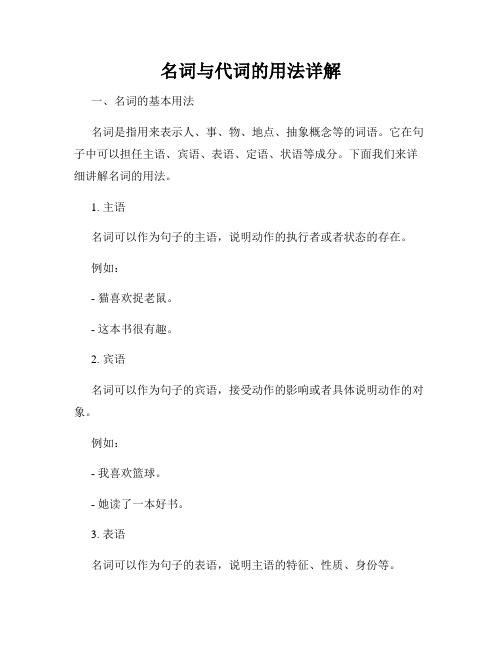
名词与代词的用法详解一、名词的基本用法名词是指用来表示人、事、物、地点、抽象概念等的词语。
它在句子中可以担任主语、宾语、表语、定语、状语等成分。
下面我们来详细讲解名词的用法。
1. 主语名词可以作为句子的主语,说明动作的执行者或者状态的存在。
例如:- 猫喜欢捉老鼠。
- 这本书很有趣。
2. 宾语名词可以作为句子的宾语,接受动作的影响或者具体说明动作的对象。
例如:- 我喜欢篮球。
- 她读了一本好书。
3. 表语名词可以作为句子的表语,说明主语的特征、性质、身份等。
例如:- 我是学生。
- 这个花园很美丽。
4. 定语名词可以作为句子的定语,修饰其他名词,限定或说明它的范围、性质等。
例如:- 我们去了一家好饭店。
- 那个大城市非常繁华。
5. 状语名词可以作为句子的状语,表示时间、地点或方式等。
例如:- 他在公园里散步。
- 我们一起去看电影。
二、代词的基本用法代词是用来代替名词的词语,用于避免重复或者指代已知的事物或概念。
根据其使用情况和功能,代词可分为人称代词、物主代词、指示代词、疑问代词、不定代词等多种类型。
人称代词用来代替特定的人或事物,分为第一人称、第二人称和第三人称。
例如:- 我喜欢读书。
- 你是我的好朋友。
- 他们正在比赛。
2. 物主代词物主代词用来表示事物的归属关系,分为所有格和宾格两种形式。
例如:- 这是我的书。
- 那是你的手机。
3. 指示代词指示代词用来指示离说话人或与说话人有关的人或事物,分为近指示和远指示两种。
例如:- 这是我刚买的新车。
- 那些花是我的妈妈种的。
疑问代词用来提问特定的人、事、物或概念。
例如:- 你想要什么礼物?- 这是谁的手机?5. 不定代词不定代词指代不确定的人或事物,具有不明确的特指对象。
例如:- 有人在敲门。
- 我想吃点东西。
总结:名词和代词在句子中有着不同的用法,名词可以作为主语、宾语、表语、定语、状语等,用来表示人、事、物、地点、抽象概念等;而代词则是用来代替名词,避免重复或者指代已知的事物或概念。
名词与代词的用法

名词与代词的用法名词和代词是英语中最常见的词类,它们在句子中起着非常重要的作用。
本文将详细介绍名词和代词的用法,并提供一些例子来帮助读者更好地理解和运用。
1. 名词的基本概念名词是用来表示人、事物、地点、抽象概念等的词语。
在句子中,名词通常作为主语、宾语、表语、定语和补语等成分出现。
例如:- 主语:Dogs are loyal animals.(狗是忠诚的动物。
)- 宾语:I bought a new book.(我买了一本新书。
)- 表语:She is a doctor.(她是一名医生。
)- 定语:The red car is mine.(那辆红车是我的。
)- 补语:He became a teacher.(他成为了一名教师。
)2. 代词的基本概念代词是用来代替名词或名词短语的词语,它可以简化语言表达,避免重复使用名词。
代词分为人称代词、物主代词、指示代词、反身代词、相互代词、疑问代词和不定代词等多种类型。
例如:- 人称代词:I, you, he, she, it, we, they(我,你,他,她,它,我们,他们)- 物主代词:my, your, his, her, its, our, their(我的,你的,他的,她的,它的,我们的,他们的)- 指示代词:this, that, these, those(这个,那个,这些,那些)- 反身代词:myself, yourself, himself, herself, itself, ourselves, themselves(我自己,你自己,他自己,她自己,它自己,我们自己,他们自己)- 相互代词:each other(彼此)- 疑问代词:who, whom, whose, what, which(谁,谁,谁的,什么,哪个)- 不定代词:some, any, no, all, both, few, many, several, each, every(一些,任何,没有,所有,两个,少数,许多,几个,每个)3. 名词和代词的用法对比名词和代词的用法有以下几点区别:3.1 名词的用法- 名词可以单数或复数形式出现,而代词则根据所代替的名词的单复数形式来选择相应的代词形式。
英语之中名词代词动词、形容词、冠词、数词、副词、介词、连词、感叹词

(一)1、名词名词(Nouns)是词性的一种,也是实词的一种,是指待人、物、事、时、地、情感、概念等实体或抽象事物的词。
名词可以独立成句。
在短语或句子中通常可以用代词来替代。
2、代词是代替名词的一种词类。
大多数代词具有名词和形容词的功能。
英语中的代词,按其意义、特征及在句中的作用分为:人称代词、物主代词、指示代词、自身代词、相互代词、疑问代词、关系代词和不定代词八种。
3、动词,就是用来形容或表示各类动作的词汇。
基本上每个完整的子句都有一个动词,要表示第二个动作时可使用不定词、动名词、对等连接词、从属连接词或增加子句等方法连结。
根据其在句中的功能,动词可分为四类。
4、形容词形容词【adjective】很多语言中均有的主要词类中的一种。
主要用来修饰名词的词,表示事物的特征5、冠词的定义冠词是置于名词之前,对名词起限制作用的一种虚词。
冠词可以说是名词的一种标志,它不能离开名词而独立存在。
冠词的分类冠词分为不定冠词"a,an"、定冠词"the"和零冠词三种6、数词表示"多少"和"第几"的词,叫数词。
其用法相当于名词或者形容词。
数词分为基数词和序数词两种。
表示数目多少或顺序多少的词叫数词,数词分为基数词和序数词。
7、副词(Adverb)副词的定义: 副词是一种用来修饰动词,形容词,副词或全句的词,说明时间,地点,程度,方式等概念。
8、介词的定义和特征介词是一种用来表示词与词, 词与句之间的关系的词。
在句中不能单独作句字成分。
介词后面一般有名词代词或相当于名词的其他词类,短语或从句作它的宾语。
(二)1、名词,人或事物的名称3、代词,代替名词或者数词(比如some就是代替数目)3、动词,动作或状态4、数词,表示数目或顺序(比如序数词,5th就是表示顺序)5、形容词,人或事物的性质或状态(因为形容词一般修饰名词)6、副词,动作的特征或性状特征(因为副词一般修饰动词或形容词)7、冠词,表示名词的泛指或特指8、介词,表示名词或代词与其他词的关系(因为介词后面一半紧跟名词,代词或其他名词性结构)9、连词,连接词与词,短语与短语,句子与句子10、感叹词,表示说话时的感情或语气(三)1、adj. / a. 形容词用来描述一类物质的性质,状态,外貌,或人的性格特点,性质,品格如:big,happy2、adv. / ad. 副词用来修饰动作或形容词,一般在句子中做状语用表示动作的进行怎样,或表示程度,特点,如:clearly,happily3、prep. 介词连接地点,时间的一类词语,可以表示方位,时间.跟一些表示时间,地点的词连用表示介词词组如:in,to,on,under4、conj. 连词用来连接时间,地点,原因,结果的一类词语如:when,beacuse,so5、num. 数词表示数字的词,既可以是基数词,也可以是序数词如:one,two,first6、int. 感叹词表示感叹的一类词,一般不加一解释,只代表感叹如:what,how,haurray7、vt. 及物动词(后面要加宾语)行为动作的词如:do,finish,play8、vi. 不及物动词(后面不加宾语)表示行为动作的词如:appear9、n. 名词表示物体,物质的词如:pig,cow,man10、pron. 代词代指一类人,事或物的词如:he,she,hers,his,things11、art = 冠词,article的缩写(四)在英语语法中主要把词分为8大类:1.名词:表示人、物或地方等,如:John,teacher;table,pen;London;beauty.2.代词:用来代替名词,以避免重复某个名词,如:I,you,it,that,those,them.3.形容词:用来修饰或限制某个(些)名词,如:good(man),white (paper),every(book),much(water),(John is)hon-est,(He seems)lazy.被修饰或限制的名词,叫做主体词(head-word)。
名词与代词如何正确使用名词与代词
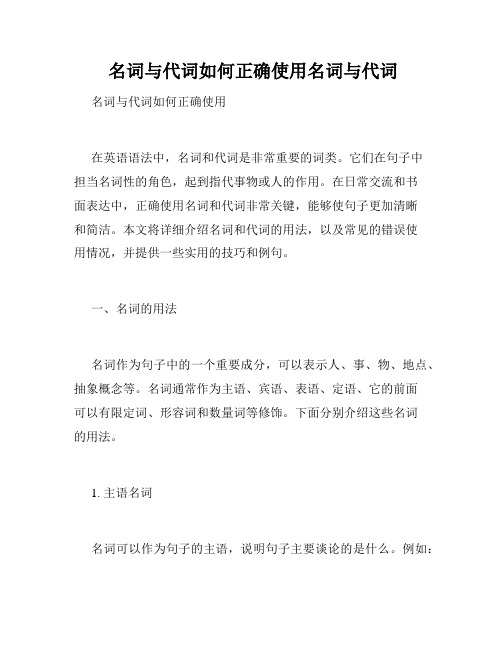
名词与代词如何正确使用名词与代词名词与代词如何正确使用在英语语法中,名词和代词是非常重要的词类。
它们在句子中担当名词性的角色,起到指代事物或人的作用。
在日常交流和书面表达中,正确使用名词和代词非常关键,能够使句子更加清晰和简洁。
本文将详细介绍名词和代词的用法,以及常见的错误使用情况,并提供一些实用的技巧和例句。
一、名词的用法名词作为句子中的一个重要成分,可以表示人、事、物、地点、抽象概念等。
名词通常作为主语、宾语、表语、定语、它的前面可以有限定词、形容词和数量词等修饰。
下面分别介绍这些名词的用法。
1. 主语名词名词可以作为句子的主语,说明句子主要谈论的是什么。
例如:- Dogs are loyal animals. (狗是忠诚的动物。
)- Dreams can come true. (梦想可以实现。
)2. 宾语名词名词可以作为及物动词或介词的宾语,说明动作的接受者或作用对象。
例如:- She likes music. (她喜欢音乐。
)- I bought a book for him. (我给他买了一本书。
)3. 表语名词名词可以作为系动词后面的表语,用来描述或说明主语的身份、特征、状态等。
例如:- The winner is him. (获胜者是他。
)- The cat looks cute. (那只猫看起来很可爱。
)4. 定语名词名词可以作为修饰其他名词的定语,用来限定或描述被修饰的名词。
例如:- A black cat is in the garden. (花园里有一只黑猫。
)- The book on the table is mine. (桌子上的那本书是我的。
)二、代词的用法代词是用来代替名词的词语,能够简化句子、避免重复,并引导读者或听者理解上下文。
代词分为人称代词、物主代词、指示代词、疑问代词、不定代词等。
1. 人称代词人称代词用来指代人的身份或角色,根据不同的人称和数分为第一人称单数、第一人称复数、第二人称单数、第二人称复数、第三人称单数和第三人称复数。
代词和名词所有格

所有格
所有格:是指有些名词+’s组成的一种格式,用来表示所属关系。
如:Lucy’s(露西的)Robert’s(罗伯特的)
区分:he’s it’s who’s what’s that’s中的’s=is,译为“...是”,这是一种缩写形式。
练习:Lucy’smy daughter.Lucy is,译为“露西是”。
This isLucy’sbag.Lucy’s,译为“露西的”。
代词(pronoun—pron.)
定义:代替某些词在句中发挥作用。
(1)指示代词:
近指
远指
单数
this(这,这个)
that(那,那个)
复数
these(这些)
those(那些)
(2)人称代词:
主格(做主语)
宾格(做宾语)
单数
复数
单数
复数
第一人称
I
we
me
us
第二人称
you
you
you
you
第三人称
he,she,it
they
him,her,it
them
(3)物主代词:指代某物的所属。
形容词性物主代词
(=adj.译为“某人的”)
名词性物主代词
(=n.译为“某人的某物”)
单数
复数
单数
复数
第一人称
my
our
mine
ours
第二人称
your
your
yours
yours
第三人is,hers,its
英语基础语法之名词、代词
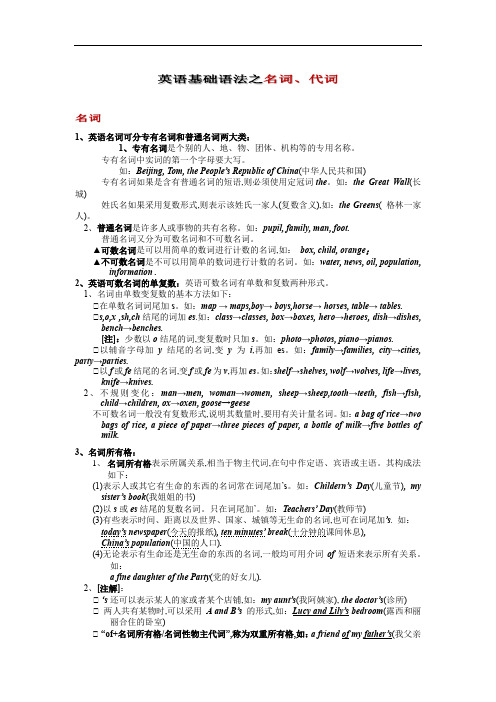
1、英语名词可分专有名词和普通名词两大类:1、专有名词是个别的人、地、物、团体、机构等的专用名称。
专有名词中实词的第一个字母要大写。
如:Beijing, Tom, the People’s Republic of China(中华人民共和国)专有名词如果是含有普通名词的短语,则必须使用定冠词the。
如:the Great Wall(长城)姓氏名如果采用复数形式,则表示该姓氏一家人(复数含义),如:the Greens( 格林一家人)。
2、普通名词是许多人或事物的共有名称。
如:pupil, family, man, foot.普通名词又分为可数名词和不可数名词。
▲可数名词是可以用简单的数词进行计数的名词,如:box, child, orange;▲不可数名词是不可以用简单的数词进行计数的名词。
如:water, news, oil, population, information .2、英语可数名词的单复数:英语可数名词有单数和复数两种形式。
1、名词由单数变复数的基本方法如下:①在单数名词词尾加s。
如:map → maps,boy→ boys,horse→ horses, table→ tables.①s,o,x ,sh,ch结尾的词加es.如:class→classes, box→boxes, hero→heroes, dish→dishes,bench→benches.[注]:少数以o结尾的词,变复数时只加s。
如:photo→photos, piano→pianos.①以辅音字母加y结尾的名词,变y为i,再加es。
如:family→families, city→cities, party→parties.①以f或fe结尾的名词,变f或fe为v,再加es。
如:shelf→shelves, wolf→wolves, life→lives,knife→knives.2、不规则变化:man→men, woman→women, sheep→sheep,tooth→teeth, fish→fish,child→children, ox→oxen, goose→geese不可数名词一般没有复数形式,说明其数量时,要用有关计量名词。
汉语名词代词知识点总结
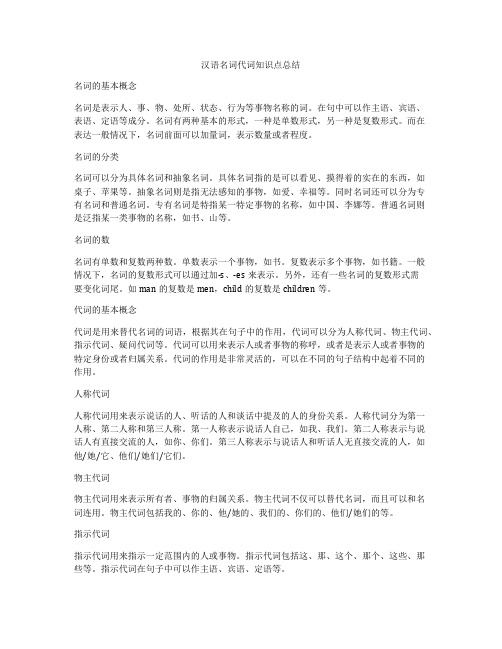
汉语名词代词知识点总结名词的基本概念名词是表示人、事、物、处所、状态、行为等事物名称的词。
在句中可以作主语、宾语、表语、定语等成分。
名词有两种基本的形式,一种是单数形式,另一种是复数形式。
而在表达一般情况下,名词前面可以加量词,表示数量或者程度。
名词的分类名词可以分为具体名词和抽象名词。
具体名词指的是可以看见、摸得着的实在的东西,如桌子、苹果等。
抽象名词则是指无法感知的事物,如爱、幸福等。
同时名词还可以分为专有名词和普通名词。
专有名词是特指某一特定事物的名称,如中国、李娜等。
普通名词则是泛指某一类事物的名称,如书、山等。
名词的数名词有单数和复数两种数。
单数表示一个事物,如书。
复数表示多个事物,如书籍。
一般情况下,名词的复数形式可以通过加-s、-es来表示。
另外,还有一些名词的复数形式需要变化词尾。
如man的复数是men,child的复数是children等。
代词的基本概念代词是用来替代名词的词语,根据其在句子中的作用,代词可以分为人称代词、物主代词、指示代词、疑问代词等。
代词可以用来表示人或者事物的称呼,或者是表示人或者事物的特定身份或者归属关系。
代词的作用是非常灵活的,可以在不同的句子结构中起着不同的作用。
人称代词人称代词用来表示说话的人、听话的人和谈话中提及的人的身份关系。
人称代词分为第一人称、第二人称和第三人称。
第一人称表示说话人自己,如我、我们。
第二人称表示与说话人有直接交流的人,如你、你们。
第三人称表示与说话人和听话人无直接交流的人,如他/她/它、他们/她们/它们。
物主代词物主代词用来表示所有者、事物的归属关系。
物主代词不仅可以替代名词,而且可以和名词连用。
物主代词包括我的、你的、他/她的、我们的、你们的、他们/她们的等。
指示代词指示代词用来指示一定范围内的人或事物。
指示代词包括这、那、这个、那个、这些、那些等。
指示代词在句子中可以作主语、宾语、定语等。
疑问代词疑问代词用来提问或者询问人或事物的身份,状况等。
语法知识名词与代词
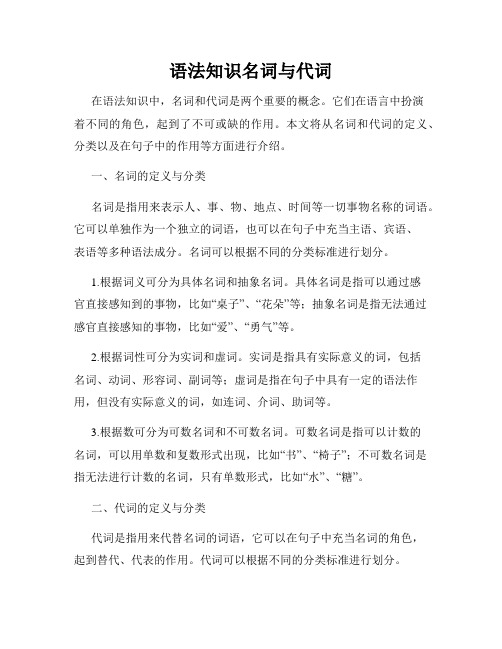
语法知识名词与代词在语法知识中,名词和代词是两个重要的概念。
它们在语言中扮演着不同的角色,起到了不可或缺的作用。
本文将从名词和代词的定义、分类以及在句子中的作用等方面进行介绍。
一、名词的定义与分类名词是指用来表示人、事、物、地点、时间等一切事物名称的词语。
它可以单独作为一个独立的词语,也可以在句子中充当主语、宾语、表语等多种语法成分。
名词可以根据不同的分类标准进行划分。
1.根据词义可分为具体名词和抽象名词。
具体名词是指可以通过感官直接感知到的事物,比如“桌子”、“花朵”等;抽象名词是指无法通过感官直接感知的事物,比如“爱”、“勇气”等。
2.根据词性可分为实词和虚词。
实词是指具有实际意义的词,包括名词、动词、形容词、副词等;虚词是指在句子中具有一定的语法作用,但没有实际意义的词,如连词、介词、助词等。
3.根据数可分为可数名词和不可数名词。
可数名词是指可以计数的名词,可以用单数和复数形式出现,比如“书”、“椅子”;不可数名词是指无法进行计数的名词,只有单数形式,比如“水”、“糖”。
二、代词的定义与分类代词是指用来代替名词的词语,它可以在句子中充当名词的角色,起到替代、代表的作用。
代词可以根据不同的分类标准进行划分。
1.根据代替范围可分为人称代词、物主代词、指示代词、疑问代词、不定代词等。
人称代词是指用来代替特定人称的代词,如“我”、“你”、“他”等;物主代词是指用来代替特定物主的代词,如“我的”、“你的”、“他的”等;指示代词是指用来指示特定事物的代词,如“这个”、“那个”等;疑问代词是指用来提问特定事物的代词,如“谁”、“哪个”等;不定代词是指用来代替不确定事物的代词,如“一些”、“任何”等。
2.根据词性可分为人称代词、反身代词、指示代词、相互代词等。
人称代词是指用来代替人的代词,如“他”、“她”、“我们”等;反身代词是指用来表示动作反射到自己身上的代词,如“自己”、“他们自己”等;指示代词是指用来指示事物的代词,如“这个”、“那个”等;相互代词是指表示两个或多个人或物之间相互关系的代词,如“彼此”、“互相”等。
什么是名词代词动词副词形容词介词数词
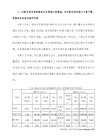
aux.v = 助动词 ,auxiliary的缩写
adj = 形容词,adjective的缩写
adv= 副词,adverb的缩写
art = 冠词,article的缩写
num = 数词,numeral的缩写
int = 感叹词,interjection的缩写
有些及物动词可以带两个宾语,往往一个指人,一个指物,指人的叫间接宾语,指物的叫直接宾语。
He gave me some ink.他给了我一点墨水。
有些及物动词的宾语后面还需要有一个补足语,意思才完整,宾语和它的补足语构成复合宾语。如:
We make him our monitor.我们选他当班长。
定语
在句中修饰名词或代词的成分叫定语。
用作定语的主要是形容词,代词,数词,名词,副词,动词不定式,介词短语等。形容词,代词,数词,名词等作定语时,通常放在被修饰的词前面。
He is a new student.他是个新生。
但副词,动词不定式,介词短语等作定语时,则放在被修饰的词之后。
u = 不可数名词,uncountable noun的缩写
c = 可数名词,countable noun的缩写
pl = 复数,plural的缩写
英语句子成分有主语,谓语,表语,宾语,宾语补足语,定语,状语等。
主语表示句子主要说明的人或事物,一般由名词,代词,数词,不定式等充当
如:He likes watching TV.他喜欢看电视
prep = 介词;前置词,preposition的缩写
pron = 代词,pronoun的缩写
n = 名词,noun的缩写
语法归纳总结常见的名词与代词用法

语法归纳总结常见的名词与代词用法名词与代词是英语语法中非常重要的部分,它们在句子中起着不同的作用。
本文将对常见的名词与代词的用法进行归纳总结,帮助读者更好地理解和应用。
一、名词的基本用法名词是表示人、事物、地点、想法等具体或抽象概念的词语。
名词的基本用法如下:1. 单数与复数名词可以表示单数或复数形式,单数表示一个人或物,复数表示两个或两个以上的人或物。
名词的复数形式通常在词尾加上字母"s",但也有一些特殊的复数形式,如"child"变成"children"。
2. 可数与不可数名词可数名词可以用来计数,可以有单数形式和复数形式,如"book"(单数)和"books"(复数)。
不可数名词表示抽象概念或无法具体计数的名词,它们没有复数形式,如"water"和"information"。
3. 名词的所有格所有格用于表示所属关系或归属关系。
常见的名词所有格形式为在名词后面加上"的",如"Tom的书"。
当名词以"s"结尾时,只需在名词后加上"'",如"James' book"。
但当名词以"s"结尾且不是复数时,需要在名词后加上"的",如"Paris的塔"。
二、代词的基本用法代词是用来替代名词或名词短语的词语,它们可以起到简化句子结构,避免重复使用名词的作用。
代词的基本用法如下:1. 主格与宾格代词根据其在句子中的作用可以分为主格和宾格。
主格代词用于作为主语,宾格代词用于作为宾语,如"I"(主格)和"me"(宾格)。
2. 形容词性与名词性代词还可以分为形容词性和名词性代词。
语法1 名词与代词

第一节:名词与代词1.名词的种类专有名词:特指人或事物的名称,首字母需要大写,包括人名,地名,书名,月份,星期,组织机构名称等。
如:Barack Obama 奥巴马September 九月Europe 欧洲the United Nations 联合国Wednesday 星期三普通名词:泛指一类人或事物的共有名称。
普通名词又分为四种:个体名词,集体名词,物质名词和抽象名词。
(1)个体名词:表示单个人或事物。
Child 孩子teacher 老师school 学校Company 公司street 街道city 城市(2)集体名词:表示多个人或事物的总称Crew 全体人员police 警察people 人们Youth 青年人furniture 家居cattle 牛(3)物质名词:表示物质的名称,包括表示材料、液体、气体、食物、饮料等名词Gold 金子ink 墨水wind 风Sugar 糖sand 沙子food 食品(4)抽象名词:表示抽象概念的名称,包括表示性质、状态、情感等的名词Progress 进步happiness 幸福kindness 善良Knowledge 知识anger 愤怒hatred 仇恨2.名词的数:即可数名词和不可数名词1)可数名词:有单数和复数之分;名词复数的构成方法有规则和不规则变化a.规则变化①绝大数的名词复数是在名词后直接加sMap ------ book----- grade ------Play------ face----- house-----②以字母s, sh, ch, x 结尾和以辅音字母+o 结尾的名词变复数时加—esBus----- dish--- inch----Box---- hero--- tomato---Potato--- volcano- ---③以字母f或fe 结尾的名词变成复数形式时,要把f或fe 改为v ,再加—esLife---- leaf---- half------Knife----- shelf ----- handkerchief---PS: belief----- gulf----- roof----Safe----④以辅音字母+y 结尾的名词变成复数形式时,要把y 改成i, 再加-esStory--- baby--- country-----b.不规则变化①改变单数名词中的元音字母Man-- foot--- woman---Tooth--- goose---②单,复数形式相同Sheep dear③特殊形式Child--- ox---- mouse---Phenomenon---- datum--- criterion---④表示“某国”人的名词单数、复数形式因习惯而各异A.单复数形式相同a Chinese -----two Chinese a Japanese---two JapaneseB.词尾加-sRussian GermanC.变man为menAn Englishman-----two Englishmen a Dutchman----two Dutchmen(3)复合名词的复数形式①写成一个词且不含连字符者,通常在第二部分加复数词尾。
英语单词词性分类:名词和代词的区别与联系
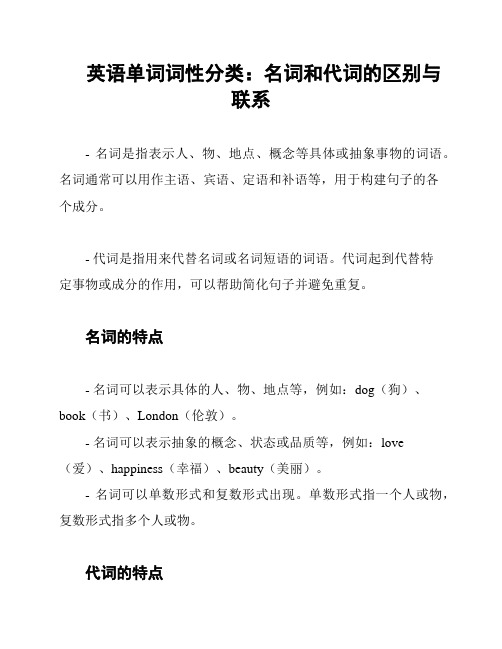
英语单词词性分类:名词和代词的区别与
联系
- 名词是指表示人、物、地点、概念等具体或抽象事物的词语。
名词通常可以用作主语、宾语、定语和补语等,用于构建句子的各
个成分。
- 代词是指用来代替名词或名词短语的词语。
代词起到代替特
定事物或成分的作用,可以帮助简化句子并避免重复。
名词的特点
- 名词可以表示具体的人、物、地点等,例如:dog(狗)、book(书)、London(伦敦)。
- 名词可以表示抽象的概念、状态或品质等,例如:love (爱)、happiness(幸福)、beauty(美丽)。
- 名词可以单数形式和复数形式出现。
单数形式指一个人或物,复数形式指多个人或物。
代词的特点
- 代词可以替代一个或多个名词,避免重复使用。
例如:He (他)代替名词John(约翰)。
- 代词可以分为人称代词、物主代词、指示代词、不定代词等
不同种类。
- 代词可以用来指示特定的人或物(指示代词),表达所属关
系(物主代词),或用于特定句子结构中的定语从句和主语从句等。
名词和代词的联系
- 名词和代词都可以用来表示人、物、地点和概念等。
- 名词和代词都可以在句子中充当不同的语法角色,例如主语、宾语、定语和补语等。
- 在一些情况下,代词可以替代特定名词,实现简化句子的效果。
因此,虽然名词和代词有一些共同点,但它们之间仍存在一些
明显的区别。
名词更侧重于表示具体或抽象事物,而代词则更侧重
于替代和简化句子中的名词成分。
在学习和使用英语时,准确理解
和正确使用名词和代词的区别是很重要的。
高中英语知识点归纳名词与代词的转化

高中英语知识点归纳名词与代词的转化高中英语知识点归纳:名词与代词的转化在英语语法中,名词和代词是两个重要的语法类别。
它们在句子中起着不同的作用和功能。
在本文中,我们将讨论名词和代词之间的转化关系,以及它们的特点和用法。
一、名词的转化为代词1. 指示代词的转化名词可以通过转化为指示代词来使用。
指示代词包括this, that,these和those等。
当我们想要用代词来代指前文中已经提到的名词时,可以使用这些指示代词。
例句:- I have three apples. This is the sweetest one.- Those are my books. These are yours.2. 不定代词的转化不定代词例如something, anything, nothing, everything等,可以由名词转化而来。
不定代词用于泛指某个事物或事物的数量。
例句:- I want something to drink. (something是不定代词,代替了前文中的名词)- Do you have anything to eat? (anything代替了前文中的名词)3. 复数名词的转化复数名词可以通过代词的形式来代指多个事物,这些代词包括they, them, their等。
例句:- The girls are playing in the park. They are having fun.- I have invited some friends to my party. I hope they can come.二、代词的转化为名词1. 人称代词的转化人称代词例如I, you, he, she, it, we和they等,可以通过加上后缀以表示名词的概念。
例句:- I am the captain of the team. (captain是名词)- You are my best friend. (friend是名词)2. 物主代词的转化物主代词例如mine, yours, his, hers, its, ours和theirs等,可以通过加上名词或名词短语,来表示归属关系。
名词和代词的区别及用法解析
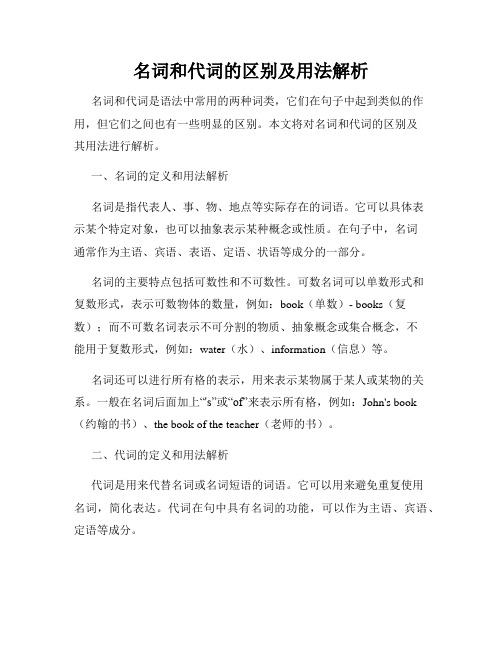
名词和代词的区别及用法解析名词和代词是语法中常用的两种词类,它们在句子中起到类似的作用,但它们之间也有一些明显的区别。
本文将对名词和代词的区别及其用法进行解析。
一、名词的定义和用法解析名词是指代表人、事、物、地点等实际存在的词语。
它可以具体表示某个特定对象,也可以抽象表示某种概念或性质。
在句子中,名词通常作为主语、宾语、表语、定语、状语等成分的一部分。
名词的主要特点包括可数性和不可数性。
可数名词可以单数形式和复数形式,表示可数物体的数量,例如:book(单数)- books(复数);而不可数名词表示不可分割的物质、抽象概念或集合概念,不能用于复数形式,例如:water(水)、information(信息)等。
名词还可以进行所有格的表示,用来表示某物属于某人或某物的关系。
一般在名词后面加上“'s”或“of”来表示所有格,例如:John's book (约翰的书)、the book of the teacher(老师的书)。
二、代词的定义和用法解析代词是用来代替名词或名词短语的词语。
它可以用来避免重复使用名词,简化表达。
代词在句中具有名词的功能,可以作为主语、宾语、定语等成分。
代词分为人称代词、物主代词、指示代词、反身代词、疑问代词、不定代词等不同类型。
1. 人称代词:用来指代人的词语,包括主格和宾格两种形式。
主格包括I、you、he/she/it、we、they,宾格包括me、you、him/her/it、us、them。
例如:I am a student.(我是一名学生。
)2. 物主代词:用来表示所属关系,包括形容词性和名词性两种形式。
形容词性物主代词包括my、your、his/her/its、our、their,修饰名词时位于名词前;名词性物主代词包括mine、yours、his/hers、ours、theirs,可以单独作为一个名词使用。
例如:This book is mine.(这本书是我的。
名词与代词的区分
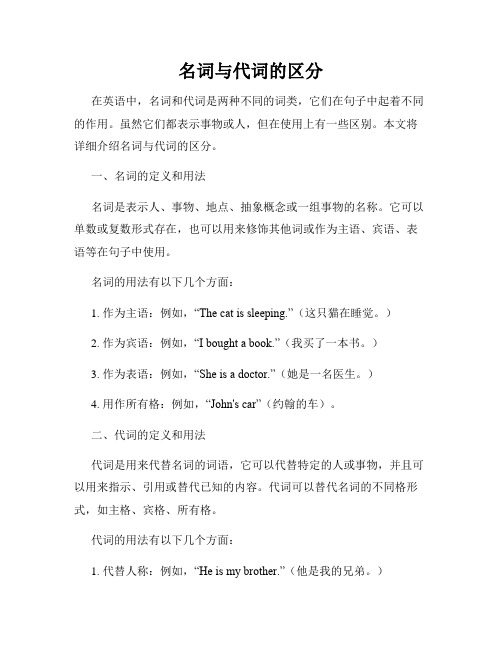
名词与代词的区分在英语中,名词和代词是两种不同的词类,它们在句子中起着不同的作用。
虽然它们都表示事物或人,但在使用上有一些区别。
本文将详细介绍名词与代词的区分。
一、名词的定义和用法名词是表示人、事物、地点、抽象概念或一组事物的名称。
它可以单数或复数形式存在,也可以用来修饰其他词或作为主语、宾语、表语等在句子中使用。
名词的用法有以下几个方面:1. 作为主语:例如,“The cat is sleeping.”(这只猫在睡觉。
)2. 作为宾语:例如,“I bought a book.”(我买了一本书。
)3. 作为表语:例如,“She is a doctor.”(她是一名医生。
)4. 用作所有格:例如,“John's car”(约翰的车)。
二、代词的定义和用法代词是用来代替名词的词语,它可以代替特定的人或事物,并且可以用来指示、引用或替代已知的内容。
代词可以替代名词的不同格形式,如主格、宾格、所有格。
代词的用法有以下几个方面:1. 代替人称:例如,“He is my brother.”(他是我的兄弟。
)2. 指示代词:例如,“This is my bag.”(这是我的包。
)3. 不定代词:例如,“Somebody called you.”(有人给你打电话。
)4. 相互代词:例如,“They love each other.”(他们彼此相爱。
)三、区分名词和代词的方法在判断一个词是名词还是代词时,可以根据以下几个特点进行区分:1. 位置:名词通常在句子中担任主语、宾语或表语的角色,而代词则用来取代名词并在句子中充当相同的角色。
2. 可数性:名词可以是可数名词或不可数名词,而代词本身并不具有可数性。
3. 修饰性:名词通常可以被形容词或其他词修饰,而代词则作为一个整体来使用。
例如,考虑以下两个句子:1. "The dog is cute."(这只狗很可爱。
)2. "It is cute."(它很可爱。
名词 → 代词
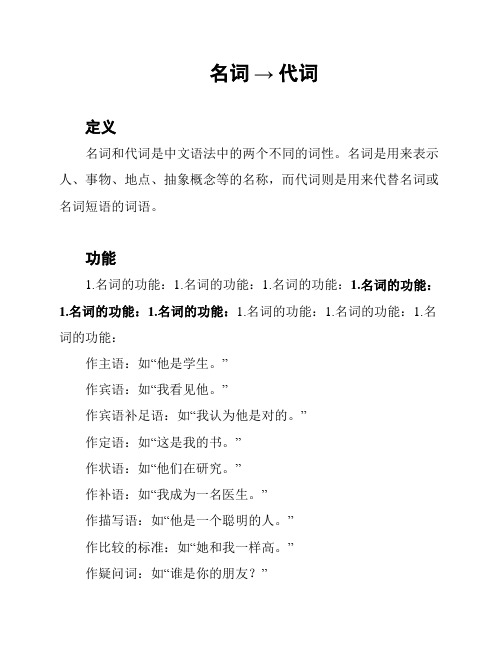
名词→ 代词定义名词和代词是中文语法中的两个不同的词性。
名词是用来表示人、事物、地点、抽象概念等的名称,而代词则是用来代替名词或名词短语的词语。
功能1.名词的功能:1.名词的功能:1.名词的功能:1.名词的功能:1.名词的功能:1.名词的功能:1.名词的功能:1.名词的功能:1.名词的功能:作主语:如“他是学生。
”作宾语:如“我看见他。
”作宾语补足语:如“我认为他是对的。
”作定语:如“这是我的书。
”作状语:如“他们在研究。
”作补语:如“我成为一名医生。
”作描写语:如“他是一个聪明的人。
”作比较的标准:如“她和我一样高。
”作疑问词:如“谁是你的朋友?”作连词:如“他喜欢唱歌还喜欢跳舞。
”2.代词的功能:2.代词的功能:2.代词的功能:2.代词的功能:2.代词的功能:2.代词的功能:2.代词的功能:2.代词的功能:2.代词的功能:代替某一特定的名词:如“我喜欢那只猫。
” → “我喜欢它。
”代替不确定的名词:如“有人打电话给你。
” → “有人打电话给我。
”代替前一句话中提到的名词:如“他是个好学生。
他总是努力研究。
” → “他是个好学生,他总是努力研究。
”代替整个句子的内容:如“他说他会来。
” → “他说会来。
”代替整个段落或文章的内容:如“我认为这非常有趣。
” → “我认为如此。
”使用规则1.代词的选择:1.代词的选择:1.代词的选择:1.代词的选择:1.代词的选择:1.代词的选择:1.代词的选择:1.代词的选择:1.代词的选择:人称代词:我、你、他、她、它、我们、你们、他们物主代词:我的、你的、他的、她的、它的、我们的、你们的、他们的指示代词:这、那、这些、那些疑问代词:谁、什么、哪个、哪些关系代词:他、她、它、谁、什么、哪个、哪些、那反身代词:自己、自己的不定代词:一些、一切、任何人、任何事物数词代词:第一、第二、几个时间代词:现在、以前、以后地点代词:这里、那里、哪里方位代词:上面、下面、前面、后面2.代词变化:2.代词变化:2.代词变化:2.代词变化:2.代词变化:2.代词变化:2.代词变化:2.代词变化:2.代词变化:主格(作主语):我、你、他、她、它、我们、你们、他们宾格(作宾语或宾语补足语):我、你、他、她、它、我们、你们、他们形容词性物主代词(作定语):我的、你的、他的、她的、它的、我们的、你们的、他们的名词性物主代词(作补足语):我的、你的、他的、她的、它的、我们的、你们的、他们的形容词性指示代词(作定语):这个、那个、这些、那些名词性指示代词(作补足语):这个、那个、这些、那些形容词性疑问代词(作定语):哪个、哪些名词性疑问代词(作补足语):谁的、什么、哪个、哪些形容词性关系代词(作定语):关系代词+名词,如“我的书”名词性关系代词(作补足语):关系代词+名词,如“我的书”不定代词:一些、一切、某些、另一些、任何人、任何事物等举例名词名词名词名词我是学生。
- 1、下载文档前请自行甄别文档内容的完整性,平台不提供额外的编辑、内容补充、找答案等附加服务。
- 2、"仅部分预览"的文档,不可在线预览部分如存在完整性等问题,可反馈申请退款(可完整预览的文档不适用该条件!)。
- 3、如文档侵犯您的权益,请联系客服反馈,我们会尽快为您处理(人工客服工作时间:9:00-18:30)。
名词复数的构成:
名词复数形式的构成规则如下:
1)一般在单数名词词尾加—s。如:
boat—boats船,desk—desks书桌,dog—dogs狗,field—fields田地。
2)以s,sh,ch,x等结尾的名词,加—es。如:
名词与代词
———————————————————————————————— 作者:
———————————————————————————————— 日期:
ﻩ
ﻩﻩ名词与代词
名词
1.名词的定义:
名词是表示人、物、地点以及抽象概念名称的词。例如:
teacher教师engineer工程师
panda大熊猫house房屋
2)普通名词(commonnoun):专有名词之外的名词都是普通名词,普通名词又分为四类:
(1)个体名词:指作为个体存在的人或物,如:uncle叔叔,computer计算机。
(2)集体名词:指由个体组成的集体,如:army军队,government政府。
(3)物质名词:指无法分为个体的东西,如:water水,tea茶,steel钢铁。
family家庭audience听众
coffee咖啡cotton棉花
relief免除courage勇气
2.名词的分类:
英语名词可分为两类:
1)专有名词(Propernoun):它是主要指人名、地名及某些类人和事物的名称。专有名词的第一个字母必须大写。如:
Einstein爱因斯坦,Chicago芝加哥,Broadway百老汇,Buddhism佛教。
2.代词的分类:
代词可分八种:
1)人称代词
人称代词作主语时,用主格形式;作宾语时,用宾格形式。
数
单数
复 数
格
主格
宾格
主格
宾格
第一人称
I我
me
we我们
us
第二人称
you你
you
you你们
you
第三人称
he他,she她,it它
him,her,it
they他们(她们,它们)
them
2)物主代词
物主代词是表示所有关系的代词,它分两种:
himself他自己
(4)抽象名词:指状态、品质、感情等抽象概念,如:joy喜悦,youth青春
英语中的名词又可分为可数名词(countablenoun或缩写成[C])与不可数名词(uncountable noun或缩写成[U])两大类。可数名词与不可数名词的区分是英语中一个重要问题,因为它涉及到一个名词的形式和它前面加不加冠词以及加那种冠词的问题。个体名词和集体名词通常是可数名词,物质名词和抽象名词通常是不可数名词。可数名词有单数和复数两种形式;不可数名词只有单数形式。一般名词的复数以加—s或—es构成。如:
yours你的
yours你们的
第三人称
his他的,hers她的,its它的
theirs他们的(她们的,它们的)
3Байду номын сангаас反身代词
反身代词是表示或强调自身的代词,有人称和数的区别。
数
人称
单数
复数
第一人称
myself我自己
ourselves我们自己
第二人称
yourself你自己
yourselves你们自己
第三人称
class—classes班级,brush—brushes刷子,match—matches比赛,box—boxes盒子,hero—heroes英雄。
3)以f或fe结尾的名词,一般变为—ves。如:
knife—knives小刀,leaf—leaves树叶,shelf—shelves架子,thief—thieves小偷。但也有例外,如:belief—beliefs信仰,gulf—gulfs海湾,roof—roofs屋顶,safe—safes保险箱。
Jeannie always answers her professors’questionsvery well; that shows sheworksvery hardafterclass.珍妮一向对教授的问题回答得很好;这说明她课下很用功。(代词that代替前面的分句,作主语)
IhadachatwithourteacherLi. Itwas veryhelpful.我和李老师谈了一次话。这次谈话对我帮助很大。(代词it代替前面的整个句子,作主语)
4)以辅音字母+y结尾的名词,先变y为i,再加—es。如:
baby—babies婴孩,city—cities城市,factory—factories工厂,university—universities大学。但以元音字母+y结尾的名词,仅加—s。如:boy—boys男孩,ray—rays光线。
有些常用名词有不规则的复数形式。如:
(1)形容词性物主代词:
数
人称
单数
复数
第一人称
my我的
our我们的
第二人称
your你的
your你们的
第三人称
his他的,her她的, its它的
their他们的(她们的,它们的)
(2)名词性物主代词:
名词性物主代词相当于“形容词性物主代词+名词”。
数
人称
单数
复 数
第一人称
mine我的
ours我们的
第二人称
代词
1.代词的定义:
代词是代替名词以及起名词作用的短语、分句和句子的一类词。代词可以在句中作主语、宾语、表语、定语或同位语。由于有些代词有性、数、格和人称的不同形式,作为名词的代用词,代词必须同所替代的词保持性、数、人称上的一致。例如:
Your brother borrowedmypsp yesterday. Imethim this afternoon andhe gaveitbacktome.昨天你弟弟借了我的psp掌上游戏机。今天下午我遇上他,他把psp还给了我。(him,he都指代yourbrother,him作宾语,he作主语。it指代psp,作宾语)
child—children儿童,foot—feet足,man—men男人,mouse—mice老鼠,tooth—teeth牙齿,woman—women女人。
有些名词单复同形。如:
Chinese中国人,deer鹿,fish鱼,Japanese日本人,sheep羊。
有些名词通常只有复数形式。如:
scissors剪刀,trousers裤子,spectacles眼镜,belongings所有物,surroundings环境。
